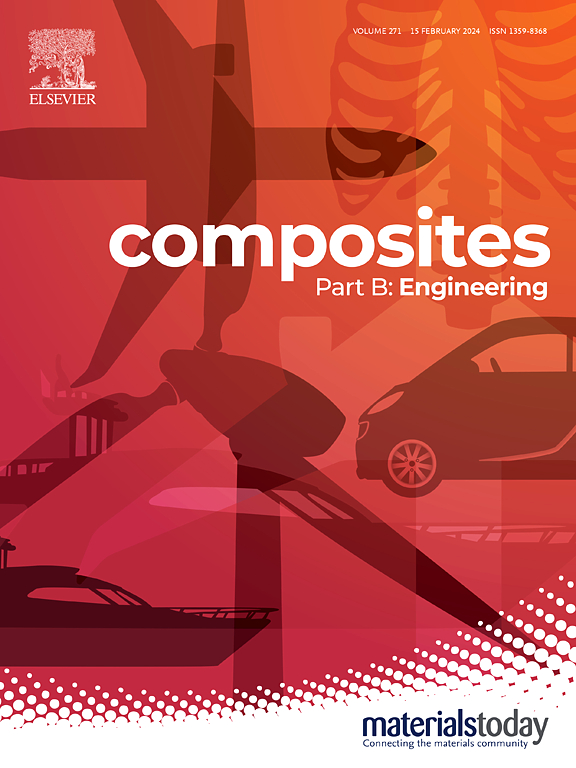Accelerating mechanism of cement hydration by hydroxyl free radicals: new perspectives from photoexcited nano-TiO2
IF 12.7
1区 材料科学
Q1 ENGINEERING, MULTIDISCIPLINARY
引用次数: 0
Abstract
Previous studies primarily considered TiO2 as a nano-filler to accelerate cement hydration due to the nucleation site effect. However, hydroxyl free radicals (•OH), released from TiO2 under UV irradiation, also exhibit great potential to accelerate cement hydration owing to their high nucleophilicity arising from unpaired electrons. This study is the first to reveal the accelerating mechanism of •OH generated by photoexcited nano-TiO2 on cement hydration. Current experimental results indicated that 5.0 wt% addition of photoexcited nano-TiO2 (under 6 h of UV irradiation during the early curing stage) improved the dissolution rate of tricalcium silicate (C3S) by 30 %, followed by a 35 % increase in the hydration degree of cement paste. More importantly, the polymerization degree and high-density content of C–S–H gels were also improved by 26 % and 13 %, accompanied by a 46 % reduction in porosity of the composites. All the aforementioned improvements were attributed to the presence of •OH generated by photoexcited nano-TiO2, which significantly accelerated cement hydration by accelerating C3S dissolution, facilitating faster nucleation and growth of C–S–H gels. In addition, the Density Functional Theory (DFT) calculations revealed that the accelerating effect of •OH on cement hydration may stem from the stronger interaction between •OH and the Ca ion on the C3S surface compared to the water molecule, and the increased surface nucleophilicity due to the dispersion of unpaired elections from •OH to all the O ions in the surface layer. These findings provide a high-efficiency approach to accelerate cement hydration by photoexcited nano-TiO2, thereby paving the way for the development of advanced and sustainable cement-based materials.
羟基自由基加速水泥水化机理:光激发纳米tio2的新视角
以往的研究主要考虑TiO2作为纳米填料,由于成核位点效应,加速水泥水化。然而,在紫外线照射下从TiO2中释放的羟基自由基(•OH),由于其由不成对电子产生的高亲核性,也表现出极大的加速水泥水化的潜力。本研究首次揭示了光激发纳米tio2生成•OH对水泥水化的加速机理。目前的实验结果表明,添加5.0 wt%的光激发纳米tio2(在养护初期,在6 h的紫外线照射下)可使硅酸三钙(C3S)的溶解率提高30%,随后使水泥浆的水化程度提高35%。更重要的是,C-S-H凝胶的聚合度和高密度含量也分别提高了26%和13%,同时复合材料的孔隙率降低了46%。上述改善都归功于光激发纳米tio2生成的•OH的存在,通过加速C3S的溶解,显著加速水泥水化,促进C-S-H凝胶更快成核和生长。此外,密度泛函理论(DFT)计算表明,•OH对水泥水化的加速作用可能源于•OH与C3S表面的Ca离子之间比水分子更强的相互作用,以及由于•OH的不配对选择分散到表层的所有O离子而增加的表面亲核性。这些发现为光激发纳米tio2加速水泥水化提供了一种高效的方法,从而为开发先进和可持续的水泥基材料铺平了道路。
本文章由计算机程序翻译,如有差异,请以英文原文为准。
求助全文
约1分钟内获得全文
求助全文
来源期刊

Composites Part B: Engineering
工程技术-材料科学:复合
CiteScore
24.40
自引率
11.50%
发文量
784
审稿时长
21 days
期刊介绍:
Composites Part B: Engineering is a journal that publishes impactful research of high quality on composite materials. This research is supported by fundamental mechanics and materials science and engineering approaches. The targeted research can cover a wide range of length scales, ranging from nano to micro and meso, and even to the full product and structure level. The journal specifically focuses on engineering applications that involve high performance composites. These applications can range from low volume and high cost to high volume and low cost composite development.
The main goal of the journal is to provide a platform for the prompt publication of original and high quality research. The emphasis is on design, development, modeling, validation, and manufacturing of engineering details and concepts. The journal welcomes both basic research papers and proposals for review articles. Authors are encouraged to address challenges across various application areas. These areas include, but are not limited to, aerospace, automotive, and other surface transportation. The journal also covers energy-related applications, with a focus on renewable energy. Other application areas include infrastructure, off-shore and maritime projects, health care technology, and recreational products.
 求助内容:
求助内容: 应助结果提醒方式:
应助结果提醒方式:


